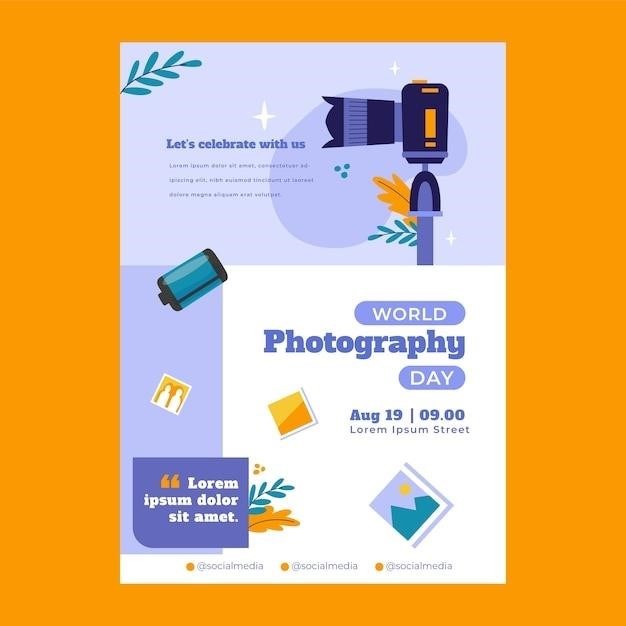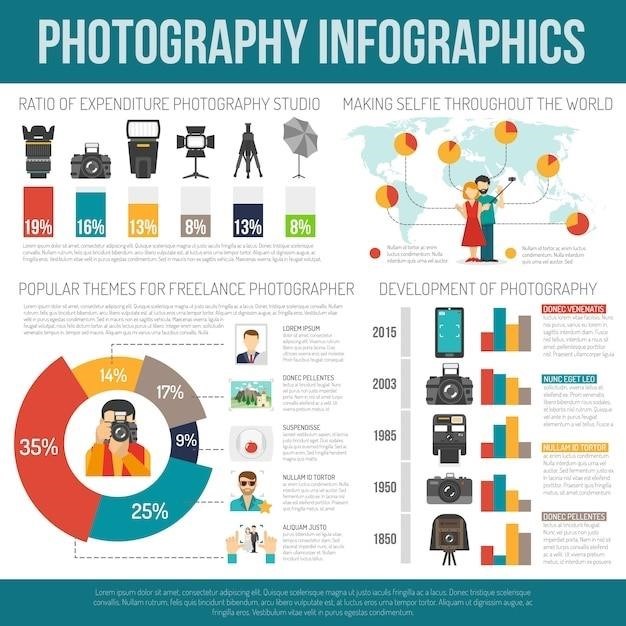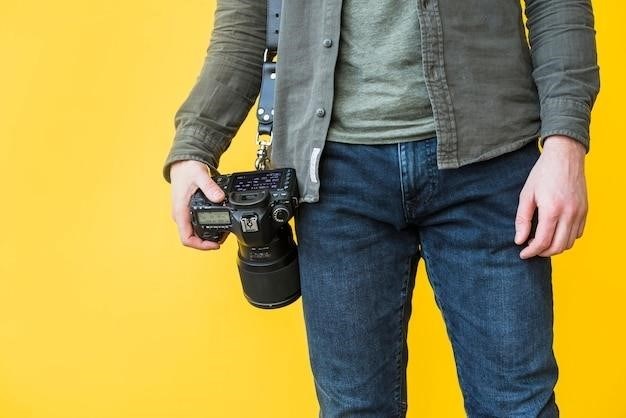d800 instruction manual

Nikon D800 Instruction Manual⁚ A Comprehensive Guide
Master your Nikon D800/D800E with this guide. Explore features, settings, troubleshooting, and FAQs. Download the PDF manual online. Find answers to common questions.
Accessing the Manual⁚ Online and Offline Options
The Nikon D800 instruction manual is readily available through multiple channels, catering to diverse user preferences. For immediate access, numerous online platforms host the manual as a downloadable PDF. These online versions offer the convenience of instant retrieval and are easily searchable. Alternatively, for offline use, consider downloading the manual to your computer or mobile device. This eliminates the need for an internet connection and ensures access at any time. The Nikon Manual Viewer 2 app, available on the App Store and Google Play, provides an additional option for viewing the manual offline on compatible devices. This app offers a user-friendly interface and convenient access to the information you need, regardless of your location or internet availability. Remember to check for the latest version available for optimal functionality.
Downloading the D800/D800E PDF Manual
Obtaining the official Nikon D800/D800E PDF manual is straightforward. Begin by navigating to Nikon’s official support website. Utilize the search function, inputting “D800 manual” or “D800E manual” for precise results. Once located, you’ll find a link to download the PDF document. This downloadable version offers a comprehensive guide, covering all aspects of your camera’s operation. The file size may be substantial; ensure you have sufficient storage space before initiating the download. After downloading, save the PDF to a convenient location on your computer or device. This allows for offline access, eliminating reliance on an internet connection for consultation. Consider printing key sections for quick reference during photography sessions. Remember that the manual covers both the D800 and D800E models, with minor exceptions clearly noted.
Firmware Updates and Installation Instructions
Keeping your Nikon D800/D800E’s firmware up-to-date is crucial for optimal performance and access to the latest features. Nikon regularly releases firmware updates addressing bugs, improving functionality, and adding new capabilities. To check for updates, visit the official Nikon support website. Use the search function to find your camera model and access the downloads section. Download the latest firmware version as a .bin file. Before installation, carefully read the accompanying instructions provided by Nikon. These instructions typically involve transferring the .bin file to an SD card, inserting the card into your camera, and then navigating through the camera’s menu system to initiate the update process. During the update, it’s critical to avoid turning off the camera or interrupting the process in any way. Once completed, verify the new firmware version is installed correctly by checking the camera’s information menu. Regularly checking for and installing firmware updates ensures your camera remains optimized and performs at its best.

Understanding Key Camera Features
Explore the Nikon D800’s core features⁚ high-resolution sensor, advanced autofocus system, versatile ISO settings, and extensive image control options.
Autofocus System⁚ Points, Modes, and Selection
The Nikon D800 boasts a sophisticated autofocus system crucial for capturing sharp images. Understanding its intricacies is key to maximizing your photographic potential. The camera features 51 autofocus points, providing extensive coverage across the frame. This allows for precise focusing on your subject, even within complex compositions. Several autofocus modes cater to diverse shooting scenarios. Single-servo autofocus (AF-S) is ideal for stationary subjects, ensuring a single, accurate focus point. Continuous-servo autofocus (AF-C) is perfect for tracking moving subjects, maintaining sharp focus throughout their movement. Automatic selection (AF-A) intelligently switches between AF-S and AF-C based on the scene’s dynamics. You can select individual autofocus points manually for precise control, or let the camera automatically select the optimal point based on the scene. Experiment with these modes and point selection to find the best approach for various photographic situations. Remember, careful attention to focusing is essential, especially given the D800’s high resolution, which magnifies any focus inaccuracies.
Image Resolution Options and Sensor Details
The Nikon D800’s exceptional image quality stems from its impressive 36.3-megapixel FX-format CMOS sensor. This sensor captures an extraordinary level of detail, resulting in images that are incredibly sharp and rich in information. The camera offers a variety of image resolution options, allowing you to tailor your image size to your specific needs. Options range from high-resolution settings ideal for large prints and significant cropping to lower resolutions for smaller files and faster processing times. Understanding these options allows for efficient workflow management. High-resolution images require more storage space and processing power, while lower resolutions are more manageable. The choice depends on your intended use. The D800’s sensor is renowned for its dynamic range, capturing a wide range of tones from deep shadows to bright highlights. This detail allows for greater flexibility in post-processing, enabling precise adjustments to exposure and contrast without losing critical image information. The sensor’s performance is particularly impressive in low-light conditions, minimizing noise even at higher ISO settings. Explore these resolution options and harness the full potential of the D800’s sensor to create stunning, high-quality images.
ISO Sensitivity and Noise Reduction Settings
Understanding ISO sensitivity and noise reduction is crucial for optimal image quality with the Nikon D800. ISO settings control the camera’s sensitivity to light; higher ISO values allow shooting in darker conditions but can introduce image noise. The D800 boasts a wide ISO range, from ISO 100 to ISO 25600, offering flexibility in various lighting scenarios. Lower ISO values (e.g., ISO 100-400) are ideal for well-lit situations, producing clean, noise-free images with maximum detail. As you increase the ISO, you’ll notice a gradual increase in noise, appearing as grain or speckles in the image. The D800 incorporates sophisticated noise reduction technology to minimize this effect, but it’s important to find a balance. The camera provides several noise reduction settings, allowing you to fine-tune the level of noise reduction applied. While strong noise reduction can significantly reduce grain, it can also slightly soften details. Experiment with different ISO and noise reduction settings to find the optimal balance between image clarity and noise reduction for your shooting style and conditions. Remember that shooting in RAW format allows for more effective noise reduction in post-processing.

Camera Settings and Controls
Master the D800’s settings⁚ shutter speed, aperture, ISO, white balance, and exposure modes. Learn to adjust these controls for perfect shots.
Shutter Speed, Aperture, and ISO Adjustment
The Nikon D800 offers precise control over shutter speed, aperture, and ISO, allowing you to fine-tune your images. Shutter speed, measured in seconds or fractions thereof, determines motion blur. Faster speeds freeze action, while slower speeds create a sense of movement. The aperture, controlled by the f-stop value (e.g., f/2.8, f/16), influences depth of field. A wider aperture (lower f-stop) results in a shallow depth of field, ideal for portraits with blurred backgrounds, while a narrower aperture (higher f-stop) provides greater depth of field, suitable for landscapes. ISO sensitivity measures the camera’s sensitivity to light. Lower ISO values (e.g., ISO 100) are best for bright conditions, producing clean images with minimal noise. Higher ISO values (e.g., ISO 6400 and above) are necessary in low-light situations but might introduce more image noise. Mastering these three elements—shutter speed, aperture, and ISO—is fundamental to achieving creative control over exposure and image quality with your D800.
White Balance Settings and Presets
Accurate white balance is crucial for achieving natural-looking colors in your photographs. The Nikon D800 offers a variety of white balance settings to compensate for different lighting conditions. Presets like Auto, Daylight, Shade, Cloudy, Fluorescent, and Incandescent are readily available, automatically adjusting the color temperature to match the ambient light. For more precise control, you can use the Custom setting, which allows you to manually adjust the white balance based on a reference point, ensuring consistent color across various shots. Inconsistent white balance leads to color casts, making images appear too warm (yellowish or orange) or too cool (blueish). By selecting the appropriate white balance setting, you can eliminate these casts and ensure true-to-life color reproduction. This feature is essential for professional-quality images, particularly in mixed lighting conditions. Experiment with these settings to achieve the desired color rendition for your photos.
Exposure Modes⁚ Manual, Aperture Priority, Shutter Priority
The Nikon D800 provides several exposure modes to suit different photographic needs and skill levels. Manual mode (M) offers complete creative control, allowing you to independently adjust shutter speed, aperture, and ISO. This mode is ideal for experienced photographers who want precise control over all aspects of exposure. Aperture Priority (A or Av) mode lets you select the aperture while the camera automatically sets the shutter speed, perfect for controlling depth of field. Shutter Priority (S or Tv) mode allows you to set the shutter speed, with the camera automatically adjusting the aperture, ideal for freezing motion or creating motion blur. Understanding these modes is crucial for mastering exposure. Each mode offers a unique balance of creative control and automation. Choose the mode that best fits your shooting style and desired level of control over the final image. Experimentation with these modes is key to developing your photographic skills and achieving your artistic vision.
Troubleshooting and FAQs
Find solutions to common Nikon D800 problems and answers to frequently asked questions. Resolve issues and optimize your camera’s performance.
Common Issues and Solutions
Encountering difficulties with your Nikon D800? This section addresses common problems and offers practical solutions. Let’s troubleshoot those pesky issues together. Are you experiencing slow autofocus? Check your autofocus mode settings and ensure sufficient lighting. Is image quality subpar? Review your ISO, aperture, and shutter speed settings; experimenting with different settings can significantly improve image quality. Experiencing blurry images? Verify that your lens is properly attached and that image stabilization is enabled if your lens supports it. Is your camera freezing or unresponsive? Try restarting the camera. If the problem persists, check for firmware updates. Is your battery draining quickly? Avoid extreme temperatures and ensure the battery is fully charged. Remember, proper lens cleaning and careful handling are vital for optimal performance. For more detailed assistance, refer to the comprehensive manual provided online.
Frequently Asked Questions about the D800
This section compiles frequently asked questions regarding the Nikon D800. Does the D800 offer live view via HDMI or USB? Yes, it does support this functionality, allowing connection to external monitors for improved subject viewing. What are the camera’s dimensions and weight? The Nikon D800 weighs approximately 900g and has dimensions of 144.78mm (width) x 121.92mm (height) x 81.28mm (depth). What is the maximum ISO sensitivity? The D800 boasts a maximum ISO of 25600, enabling low-light shooting with minimal noise. Does the camera include image stabilization? No, the D800 lacks built-in image stabilization; users should use a tripod or other stabilization methods for sharp images. What type of lens mount does it use? The D800 utilizes the Nikon F mount, compatible with a wide range of Nikon lenses. How many autofocus points are there? The camera features 51 autofocus points for precise focusing on your subject. Remember to consult the comprehensive user manual for detailed answers and further information.
Leave a Reply
You must be logged in to post a comment.